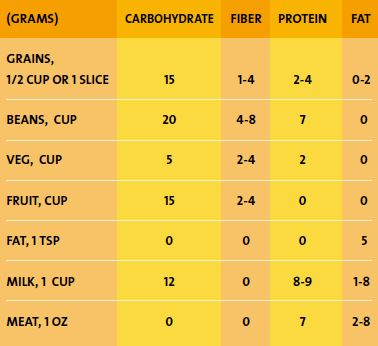Jan 9, 2017, 16:36
by
Gerri French, MS, RDN, CDE
I think most people would agree that skipping meals and lack of food can decrease energy. But can eating the wrong combinations of food or poor quality foods effect our energy? What about too much of certain types of food? Yes, Yes, and Yes. If you’re interested in achieving consistent sustained energy, enjoying wholesome balanced meals, sitting at a table can make a difference. Calories in our food provide fuel for energy; vitamins and minerals do not contain calories, therefore they do not provide direct energy although they help release the energy from food.
Learning the basics of Nutrition 101 provides answers to questions about food and energy. Foods with carbohydrates are the body’s preferable source of energy, and they provide quicker energy than protein and fats. The more active we are physically, the more carbohydrates are needed, an important concept people need to consider when they want to sit instead of move. Similar to kindling in the fire, carbohydrates don’t last long. Earth grown, natural sources of carbohydrates which contain slightly more protein and fat such as whole grains (think oatmeal) will last longer than refined flour products (like Cheerios) however these foods don’t provide satiety. Legumes or beans are especially valuable for longer lasting fuel since they contain more protein along with fiber. The component of food that keeps us most full and is usually the “last resort” for energy is fat, followed by protein. Many foods are natural combinations of all three nutrients including our first start food: breast milk or formula which contains carbohydrate, protein and healthy fat.

Although this chart is a great beginning to nutrition, it doesn’t list the nutrition in the convenience foods we often eat such as granola bars, cookies and ice cream, all of which contain sugar and possibly fiber. Each 4 grams of sugar is equivalent to one teaspoon of sugar. Table sugar, honey and maple syrup are quick sources of energy since they easily convert to blood sugar. Eating concentrated amounts of natural and refined processed carbohydrates at one sitting increases your blood sugar and need for insulin which can store fat and, in fact make some people feel tired. Foods such as pancakes with syrup, sugar sweetened cereal with banana and even large servings of wheat pasta and soda or juice can cause this effect. These high glycemic (convert to sugar quicker and higher) meals are not examples of “balanced” meals.
One additional tidbit which will illustrate this concept is fruit. Each ½ cup of fruit contains 15 grams of carbohydrate of which 12-13 grams are from sugar (the rest is fiber) along with valuable vitamins, minerals, antioxidants and phytonutrients. However as people with diabetes discover, fresh, frozen, canned or dried fruit increases blood sugar dramatically. Balancing it with foods with protein and fat as well as exercise is helpful.
Examples:
1) Quick energy from fresh or frozen fruit such as a locally grown tangerine or apple can provide more lasting energy and feeling of fullness when consumed with nuts, nut butter or cheese. Fruit contains fiber which is also helpful and sorely lacking in fruit juice; some canned fruit contains less fiber than fruit off the tree since often the peel is removed which contains the most fiber. Fiber is found in plant foods; animal foods (meat and dairy as nature makes them) and fats/oils do not contain fiber. Fiber releases sugar into our system more slowly which is helpful to sustain energy. Brown rice contains 15 grams of carbohydrate of which 3 grams will be fiber; white rice contains less than 1 gram of fiber. The daily fiber recommendation fiber for adults is at least 25 grams.
2) Corn tortilla or whole grain flour tortilla with avocado or cheese.
3) Sit down dinners typically are “balanced” with some type of meat, poultry or fish; rice, potato or pasta; and a vegetable or salad.
4) Eggs with potatoes and/or beans and/or tortillas and/or bread along with salsa, vegetables and avocado is a wonderful beginning to the day. The amount of potatoes, beans and tortillas depends to a large extent upon your weight and how active you are.
5) The typical SAD (Standard American Diet) breakfast of cold cereal, nonfat milk and banana is very concentrated in carbohydrate as are bagels, scones and muffins. They need some additional protein and fat and usually reduced portion, unless combined with physical activity.
6) What about soda and fruit juice? Yes, these drinks will increase your blood sugar and provide very quick energy, however it is storage and ultimately make you feel tired. The “lift” from soda is usually from caffeine. A large amount of caffeine, especially found in energy drinks, is not recommended for three main reasons:
- It can overstimulate your heart.
It usually disrupts sleep cycles especially in older adults.
- Caffeine can increase our stress response and shorten our fuse which can have undesirable effects.
- Excess caffeine does not provide consistent energy but rather bursts of energy which might be helpful in the short term but ultimately can deplete your energy.
A Registered Dietitian Nutritionist (RDN) can help you understand more about food and how your food choices affect you.

Gerri French, MS, is a Registered Dietitian Nutritionist (RDN) and Certified Diabetes Educator (CDE) for Sansum Clinic. Gerri has been a clinical nutritionist and cooking instructor for 30 years. She is also a mother and enjoys sharing practical information and recipes with her patients and their families.
Learn more about nutrition counseling at Sansum Clinic. >